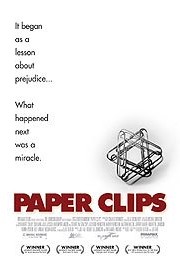Paper Clips
The overwhelming emotion that still surrounds the tragedy of the Holocaust washes over the viewer in watching “Paper Clips.” This is a documentary where the subject definitely outweighs the technical qualities of the film. The film is about classes of students in a rural Tennessee middle school who have, in studying the evil and prejudice of the Holocaust, helped teach the world about overcoming evil and inspiring good in the simplest of ways. The film by Elliot Berlin and Joe Fab isn’t a great film, but the story it tells is great and important.
In 1998, the principal at Whitwell Middle School began teaching their eighth graders about the Holocaust as a way of teaching tolerance and acceptance of those who are different. The town of Whitwell isn’t one where diversity is prevalent: at the time, there were only five blacks and one hispanic person in town. As the students become immersed in the enormity of the Holocaust, they are unable to fathom what six million of anything looks like. So the students had an idea: during WWII, the Norwegians invented the paper clip, and used it as a symbol of solidarity with the victims of the Holocaust. And so, the students of the Holocaust Project begin collecting paper clips, and the unlikeliest of museums to this global tragedy was born.
This is a film I had heard of, but my mother is the person who inspired me to finally sit down and watch it. As a film, it is rough and almost maudlin in its sentimentality, but the story it tells is an important one. By the time the students are done, and the administrators and town leaders have found an authentic German rail car to house their paper clips, they have collected over 29 million paper clips- almost three times the amount of people who died at the Nazis’s hands in the death camps. And even if that were the emotional high point of the film, that would be enough to merit the film’s existence, but there are so many others. The arrival of a suitcase, with paper clips addressed to Anne Frank and asking for forgiveness. The survivors who come to town to tell their stories of survival and loss. And the letters from celebrities and regular people who sent the school paper clips. What this community, and these children, have accomplished is beyond remarkable; it’s a miracle. Who cares if the film chronicling this achievement isn’t perfect; the act of goodness it tells of is one of hope arising from heartbreak.










